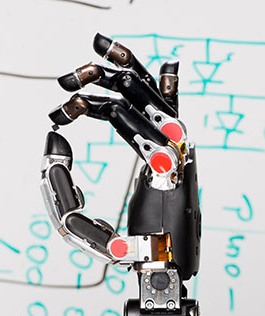Robot arm feels like the future
 Engineers in the US have reported on an advanced robotic hand wired directly into a paralysed man’s brain, providing feedback that allows him to ‘feel’.
Engineers in the US have reported on an advanced robotic hand wired directly into a paralysed man’s brain, providing feedback that allows him to ‘feel’.
The hand was developed at Johns Hopkins University’s Applied Physics Laboratory as part of a research project looking at high-tech replacement limbs.
The project is funded by the US military’s Defense Advanced Research Projects Agency (DARPA).
The 28-year-old man was paralysed by a spinal-cord injury over a decade ago. He has now had electrodes from the prosthetic hand inserted into his sensory and motor cortices.
It allows him to control the hand with his thoughts, and in a significant breakthrough, sense when each finger of the hand is touched individually.
Sensors in the robo-hand detect pressure applied to the fingers, sending electrical signals back to the body to mimic touch sensations.
The DARPA researchers say the volunteer could determine which finger on the hand was touched, while blindfolded, with nearly 100 per cent accuracy.
“Prosthetic limbs that can be controlled by thoughts are showing great promise, but without feedback from signals travelling back to the brain it can be difficult to achieve the level of control needed to perform precise movements,” DARPA program manager Justin Sanchez said.
“At one point, instead of pressing one finger, the team decided to press two without telling him.
“He responded in jest asking whether somebody was trying to play a trick on him.
“That is when we knew that the feelings he was perceiving through the robotic hand were near-natural.
“By wiring a sense of touch from a mechanical hand directly into the brain, this work shows the potential for seamless biotechnological restoration of near-natural function. We’ve completed the circuit.”
The team says that hand and the advanced neuro-technologies on which it relies could one day allow those who have lost limbs to have fully functioning replacements, but they will come with a level of control and usefulness that can only be offered with sensation.
Dr Sanchez talks about the stunning work happening at DARPA in the video below.








 Print
Print